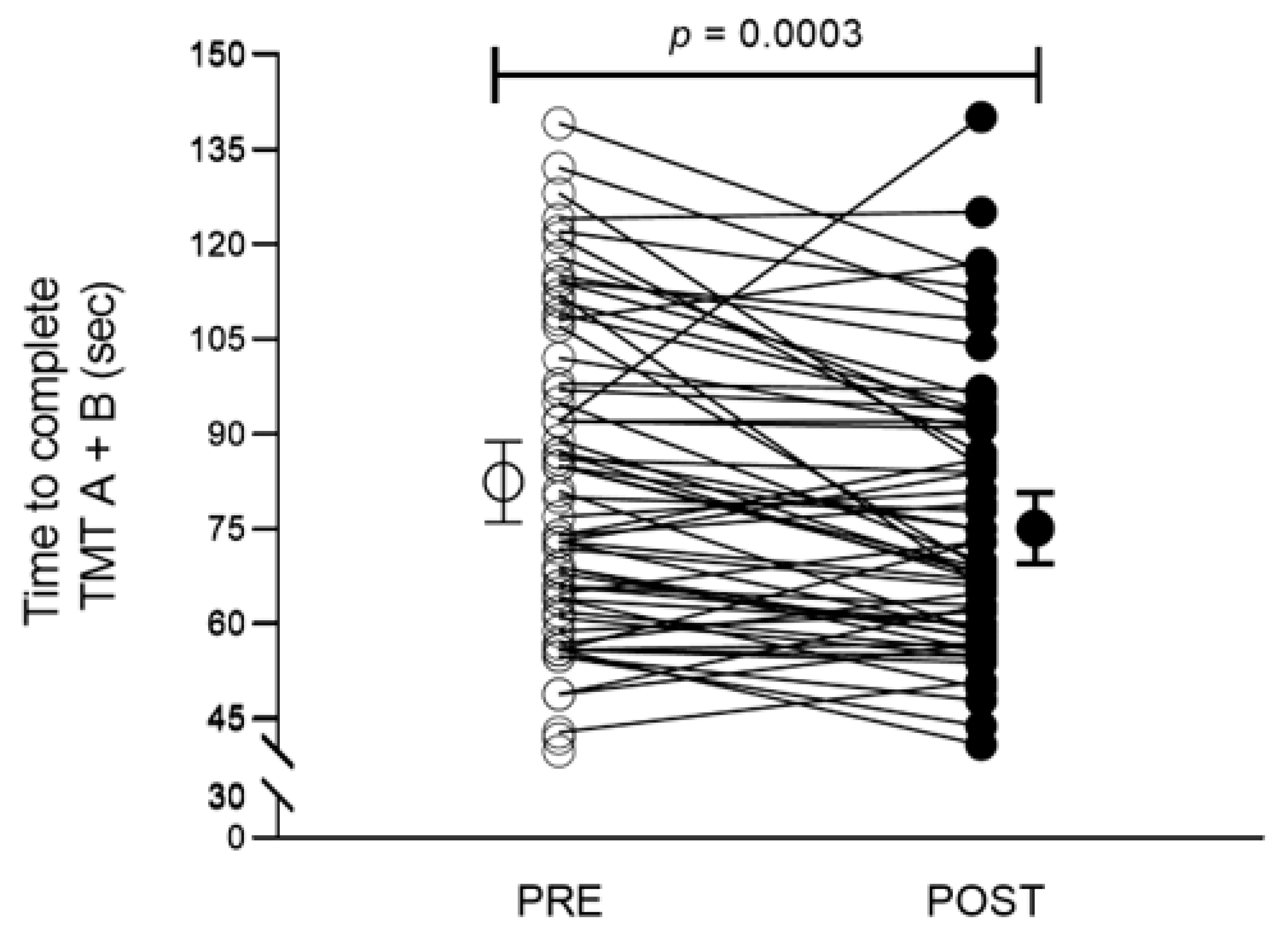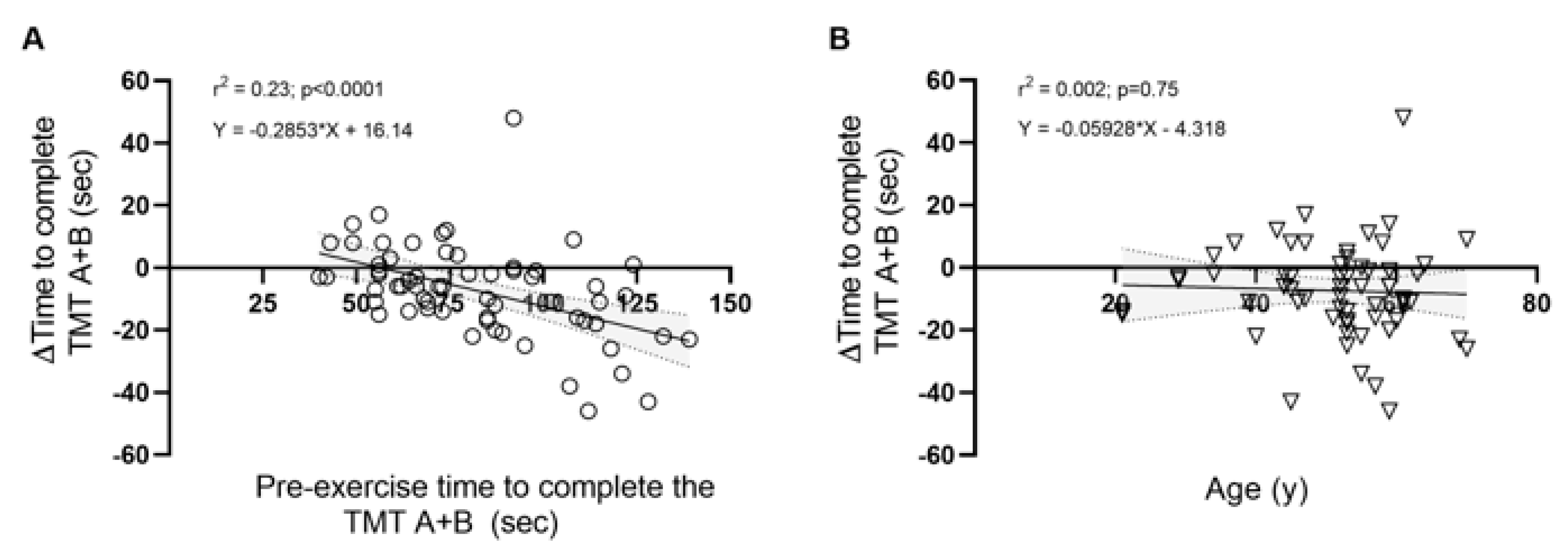Effectiveness of a Single Prolonged Aerobic Exercise Session on Executive Function Task Performance in Physically Active Adults (21–70 Years of Age)
Abstract
1. Introduction
2. Material and Methods
2.1. Study Population
2.2. Exercise Duration and Environmental Conditions
2.3. Cognitive Assessments
2.4. Outcome Variables
2.5. Statistical Analysis
3. Results
4. Discussion
Author Contributions
Funding
Institutional Review Board Statement
Informed Consent Statement
Data Availability Statement
Acknowledgments
Conflicts of Interest
References
- Erickson, K.I.; Hillman, C.; Stillman, C.M.; Ballard, R.M.; Bloodgood, B.; Conroy, D.E.; Macko, R.; Marquez, D.X.; Petruzzello, S.J.; Powell, K.E.; et al. Physical Activity, Cognition, and Brain Outcomes: A Review of the 2018 Physical Activity Guidelines. Med. Sci. Sports Exerc. 2019, 51, 1242–1251. [Google Scholar] [CrossRef] [PubMed]
- Chang, Y.K.; Erickson, K.I.; Stamatakis, E.; Hung, T.M. How the 2018 US Physical Activity Guidelines are a Call to Promote and Better Understand Acute Physical Activity for Cognitive Function Gains. Sports Med. 2019, 49, 1625–1627. [Google Scholar] [CrossRef] [PubMed]
- Yates, B.A.; Ellis, L.A.; Butts, C.L.; McDermott, B.P.; Williamson, K.H.; Armstrong, L.E. Factors Associated with Pre-Event Hydration Status and Drinking Behavior of Middle-Aged Cyclists. J. Nutr. Health Aging 2017, 22, 335–340. [Google Scholar] [CrossRef]
- Kwan, B.M.; Stevens, C.J.; Bryan, A.D. What to expect when you’re exercising: An experimental test of the anticipated affect–exercise relationship. Health Psychol. 2017, 36, 309–319. [Google Scholar] [CrossRef]
- Thompson, W.R.; Sallis, R.; Joy, E.; Jaworski, C.A.; Stuhr, R.M.; Trilk, J.L. Exercise Is Medicine. Am. J. Lifestyle Med. 2020, 14, 511–523. [Google Scholar] [CrossRef]
- Vecchio, L.M.; Meng, Y.; Xhima, K.; Lipsman, N.; Hamani, C.; Aubert, I. The Neuroprotective Effects of Exercise: Maintaining a Healthy Brain throughout Aging. Brain Plast. 2018, 4, 17–52. [Google Scholar] [CrossRef]
- Chen, F.-T.; Etnier, J.L.; Wu, C.-H.; Cho, Y.-M.; Hung, T.-M.; Chang, Y.-K. Dose-Response Relationship between Exercise Duration and Executive Function in Older Adults. J. Clin. Med. 2018, 7, 279. [Google Scholar] [CrossRef] [PubMed]
- Chang, Y.-K.; Chu, C.-H.; Wang, C.-C.; Wang, Y.-C.; Song, T.-F.; Tsai, C.-L.; Etnier, J.L. Dose–Response Relation between Exercise Duration and Cognition. Med. Sci. Sports Exerc. 2015, 47, 159–165. [Google Scholar] [CrossRef]
- Chang, Y.K.; Labban, J.D.; Gapin, J.I.; Etnier, J.L. The effects of acute exercise on cognitive performance: A meta-analysis. Brain Res. 2012, 1453, 87–101. [Google Scholar] [CrossRef]
- Ludyga, S.; Gerber, M.; Pühse, U.; Looser, V.N.; Kamijo, K. Systematic review and meta-analysis investigating moderators of long-term effects of exercise on cognition in healthy individuals. Nat. Hum. Behav. 2020, 4, 603–612. [Google Scholar] [CrossRef]
- Stillman, C.M.; Esteban-Cornejo, I.; Brown, B.; Bender, C.M.; Erickson, K.I. Effects of Exercise on Brain and Cognition Across Age Groups and Health States. Trends Neurosci. 2020, 43, 533–543. [Google Scholar] [CrossRef] [PubMed]
- Ludyga, S.; Gerber, M.; Brand, S.; Holsboer-Trachsler, E.; Pühse, U. Acute effects of moderate aerobic exercise on specific aspects of executive function in different age and fitness groups: A meta-analysis. Psychophysiology 2016, 53, 1611–1626. [Google Scholar] [CrossRef]
- McSween, M.P.; Coombes, J.S.; MacKay, C.P.; Rodriguez, A.D.; Erickson, K.I.; Copland, D.A.; McMahon, K.L. The Immediate Effects of Acute Aerobic Exercise on Cognition in Healthy Older Adults: A Systematic Review. Sports Med. 2019, 49, 67–82. [Google Scholar] [CrossRef]
- Ishihara, T.; Drollette, E.S.; Ludyga, S.; Hillman, C.H.; Kamijo, K. The effects of acute aerobic exercise on executive function: A systematic review and meta-analysis of individual participant data. Neurosci. Biobehav. Rev. 2021, 128, 258–269. [Google Scholar] [CrossRef] [PubMed]
- McCartney, D.; Desbrow, B.; Irwin, C. Cognitive effects of acute aerobic exercise: Exploring the influence of exercise duration, exhaustion, task complexity and expectancies in endurance-trained individuals. J. Sports Sci. 2020, 39, 183–191. [Google Scholar] [CrossRef]
- Benefer, M.D.; Corfe, B.M.; Russell, J.M.; Short, R.; Barker, M.E. Water intake and post-exercise cognitive performance: An observational study of long-distance walkers and runners. Eur. J. Nutr. 2012, 52, 617–624. [Google Scholar] [CrossRef]
- Grego, F.; Vallier, J.-M.; Collardeau, M.; Rousseu, C.; Cremieux, J.; Brisswalter, J. Influence of Exercise Duration and Hydration Status on Cognitive Function During Prolonged Cycling Exercise. Int. J. Sports Med. 2004, 26, 27–33. [Google Scholar] [CrossRef]
- Fiser, W.M.; Hays, N.P.; Rogers, S.C.; Kajkenova, O.; Williams, A.E.; Evans, C.M.; Evans, W.J. Energetics of Walking in Elderly People: Factors Related to Gait Speed. J. Gerontol. Ser. A 2010, 65A, 1332–1337. [Google Scholar] [CrossRef]
- Borg, G.A. Psychophysical bases of perceived exertion. Med. Sci. Sports Exerc. 1982, 14, 377–381. [Google Scholar] [CrossRef]
- Rabin, L.A.; Barr, W.B.; Burton, L.A. Assessment practices of clinical neuropsychologists in the United States and Canada: A survey of INS, NAN, and APA Division 40 members. Arch. Clin. Neuropsychol. 2005, 20, 33–65. [Google Scholar] [CrossRef] [PubMed]
- Sanders, L.M.J.; Hortobágyi, T.; la Bastide-van Gemert, S.; Van Der Zee, E.A.; Van Heuvelen, M.J.G. Dose-response relationship between exercise and cognitive function in older adults with and without cognitive impairment: A systematic review and meta-analysis. PLoS ONE 2019, 14, e0210036. [Google Scholar] [CrossRef] [PubMed]
- Guest, N.S.; VanDusseldorp, T.A.; Nelson, M.T.; Grgic, J.; Schoenfeld, B.J.; Jenkins, N.D.M.; Arent, S.M.; Antonio, J.; Stout, J.R.; Trexler, E.T.; et al. International society of sports nutrition position stand: Caffeine and exercise performance. J. Int. Soc. Sports Nutr. 2021, 18, 1–37. [Google Scholar] [CrossRef]
- Caldwell, A.R.; Tucker, M.A.; Butts, C.L.; McDermott, B.P.; Vingren, J.L.; Kunces, L.J.; Lee, E.C.; Munoz, C.X.; Williamson, K.H.; Armstrong, L.E.; et al. Effect of Caffeine on Perceived Soreness and Functionality Following an Endurance Cycling Event. J. Strength Cond. Res. 2017, 31, 638–643. [Google Scholar] [CrossRef] [PubMed]
- Muñoz, C.X.; Johnson, E.C.; Kunces, L.J.; McKenzie, A.L.; Wininger, M.; Butts, C.L.; Caldwell, A.; Seal, A.; McDermott, B.P.; Vingren, J.; et al. Impact of Nutrient Intake on Hydration Biomarkers Following Exercise and Rehydration Using a Clustering-Based Approach. Nutrients 2020, 12, 1276. [Google Scholar] [CrossRef]
- Won, J.; Alfini, A.J.; Weiss, L.R.; Nyhuis, C.C.; Spira, A.P.; Callow, D.D.; Smith, J.C. Caudate Volume Mediates the Interaction between Total Sleep Time and Executive Function after Acute Exercise in Healthy Older Adults. Brain Plast. 2019, 5, 69–82. [Google Scholar] [CrossRef] [PubMed]
- Stern, Y.; Lee, S.; Predovan, D.; Sloan, R.P. Sex Moderates the Effect of Aerobic Exercise on Some Aspects of Cognition in Cognitively Intact Younger and Middle-Age Adults. J. Clin. Med. 2019, 8, 886. [Google Scholar] [CrossRef] [PubMed]


| Demographics | Entire Sample (n = 62) |
|---|---|
| Characteristic | |
| Age, y | 51 (11) |
| 20–29, # | 4 [6.5] |
| 30–39, # | 4 [6.5] |
| 40–49, # | 13 [20.9] |
| 50–59, # | 31 [50.0] |
| 60–69, # | 8 [12.9] |
| 70, # | 2 [3.2] |
| Female gender, # | 3 [4.8] |
| Weight, kg | 87.2 (12.4) |
| Height, cm | 177 (6) |
| BMI, kg/m2 | 27.9 (3.4) |
| Body Fat, % | 13.8 (5.3) |
| Habitual gait speed, m/s | 1.07 (0.16) |
| Cognitive Performance | |
| TMT-A, sec | 27 (10) |
| TMT-B, sec | 56 (18) |
| Exercise performance | |
| Total exercise time, min a | 373 (80) |
| RPE, arbitrary units b | 16 (2) |
| Cognitive Tack | Cohen’s d Effect Size |
|---|---|
| Trail Making Test Part A, sec | 0.38 [0.12, 0.63] |
| Trail Making Test Part B, sec | 0.34 [0.01, 0.60] |
| Trail Making Test Part A + B, sec | 0.49 [0.22, 0.75] |
Disclaimer/Publisher’s Note: The statements, opinions and data contained in all publications are solely those of the individual author(s) and contributor(s) and not of MDPI and/or the editor(s). MDPI and/or the editor(s) disclaim responsibility for any injury to people or property resulting from any ideas, methods, instructions or products referred to in the content. |
© 2023 by the authors. Licensee MDPI, Basel, Switzerland. This article is an open access article distributed under the terms and conditions of the Creative Commons Attribution (CC BY) license (https://creativecommons.org/licenses/by/4.0/).
Share and Cite
Yates, B.A.; Armstrong, L.E.; Lee, E.C.; Unverzagt, F.W.; Dadzie, E., Jr.; Lopez, V., III; Williamson, K.; Vingren, J.L.; Orkaby, A.R. Effectiveness of a Single Prolonged Aerobic Exercise Session on Executive Function Task Performance in Physically Active Adults (21–70 Years of Age). Int. J. Environ. Res. Public Health 2023, 20, 2802. https://doi.org/10.3390/ijerph20042802
Yates BA, Armstrong LE, Lee EC, Unverzagt FW, Dadzie E Jr., Lopez V III, Williamson K, Vingren JL, Orkaby AR. Effectiveness of a Single Prolonged Aerobic Exercise Session on Executive Function Task Performance in Physically Active Adults (21–70 Years of Age). International Journal of Environmental Research and Public Health. 2023; 20(4):2802. https://doi.org/10.3390/ijerph20042802
Chicago/Turabian StyleYates, Brandon A., Lawrence E. Armstrong, Elaine C. Lee, Frederick W. Unverzagt, Ekow Dadzie, Jr., Virgilio Lopez, III, Keith Williamson, Jakob L. Vingren, and Ariela R. Orkaby. 2023. "Effectiveness of a Single Prolonged Aerobic Exercise Session on Executive Function Task Performance in Physically Active Adults (21–70 Years of Age)" International Journal of Environmental Research and Public Health 20, no. 4: 2802. https://doi.org/10.3390/ijerph20042802
APA StyleYates, B. A., Armstrong, L. E., Lee, E. C., Unverzagt, F. W., Dadzie, E., Jr., Lopez, V., III, Williamson, K., Vingren, J. L., & Orkaby, A. R. (2023). Effectiveness of a Single Prolonged Aerobic Exercise Session on Executive Function Task Performance in Physically Active Adults (21–70 Years of Age). International Journal of Environmental Research and Public Health, 20(4), 2802. https://doi.org/10.3390/ijerph20042802






